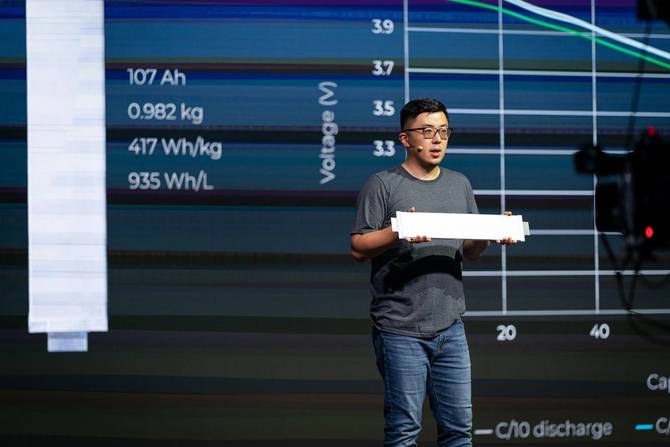Happy Wednesday. It seems like every company is trying to become a “metaverse” company now, whatever that may mean. We have one simple question: Who is building the metaverse for newsletters, and can we join?
In today’s edition:
 Lithium-metal milestone Lithium-metal milestone
🛰 Project Kuiper's timeline
⛓ Chip crunch continues
—Grace Donnelly, Jordan McDonald, Dan McCarthy
|
|
|
SES
While lithium-ion batteries are industry standard for EVs today, automakers are placing bets on companies racing to develop the “holy grail” of EV power: lithium-metal batteries.
So far, no one has put a lithium-metal battery into a car, but one company says it has moved closer to that goal.
Why it matters: Lithium-metal batteries are much lighter than the lithium-ion batteries used in EVs today. With higher energy density, these batteries could offer increased range and faster charging—capable of driving 500 to 600 miles on a single charge (compared to a top EV range of around 400 miles in 2020) and cutting charge time down from hours to minutes.
SES, a Singapore–based battery maker, announced today that it has built a 107 amp hour (Ah) hybrid lithium-metal battery—the largest in the world and the first big enough to power an electric vehicle.
- SES began as a research project at MIT in 2012 and has been working with GM since 2015. It’s raised more than $325 million to date.
“Until today, all these next-gen lithium-metal batteries that people have seen are with these very small cells, up to the size of an iPhone battery,” SES founder and CEO Qichao Hu told Emerging Tech Brew. iPhone batteries are about 4 to 6 Ah, but to power an EV, these batteries need to be about 25 times that size.
While the EV world had estimated next-generation batteries wouldn’t make it onto the roads until at least 2030, SES is now aiming to have a lithium-metal battery ready for commercially sold cars by 2025, Hu said. To make that happen, SES announced plans to build a 300,000 square-foot lithium-metal battery facility in Shanghai by 2023.
- The company began construction on the Shanghai Giga facility in Q3. Hu says it will be able to produce 1 Gwh of lithium-metal batteries annually once completed.
- “Compared to lithium ion, which has hundreds of gigawatt hours of capacity globally, it doesn’t seem like a lot. But for lithium metal it’s by far the largest,” he said.
Looking ahead…SES also plans to go public via a SPAC merger with Ivanhoe Capital Acquisition Corp.—led by mining titan Robert Friedland—in a $3.6 billion deal expected to close by the end of 2021.
“I don't think we can underestimate the significance of the period that we're going through,” Hu said of the automotive industry. “I've never seen it in the past century and it probably won't won't happen again. There is a ton of money and resources being poured into the development of new battery technologies.”
Click here to read the full story.—GD
|
|
|
Amazon
On Monday, Amazon filed an experimental license request with the FAA to launch the first satellites for its long-awaited Starlink competitor Project Kuiper, following FCC approval of the project last year.
The satellites are expected to hit the skies in Q4 2022, and are the first step in Amazon’s planned $10 billion mission to provide satellite-based internet to rural areas around the world.
- Amazon says Kuiper’s constellation will eventually number 3,236 satellites, and the company is in a race against the clock to launch half that number by mid-2026.
- If it fails to do so, the FCC could choose to stop Kuiper in its tracks, per the conditions set in the project’s approval.
Amazon says it will also take steps to address the most contentious issues in satellite deployment, like limiting the visibility of its satellites and deorbiting them post-mission to mitigate space junk.
For its part...SpaceX's Starlink has already launched 1,740 satellites, and recently registered its business in India, where it plans to deploy 200,000 active terminals in over 160,000 districts by December 2022.
- Starlink was also supposed to come out of beta in October, but it suffered the fate of many an Elon Musk timeline prediction.
Zoom out: Amazon also announced last week that it’s entering a joint partnership with Verizon on Project Kuiper, focused on expanding connectivity to rural and remote areas. Verizon declined to provide detail on the project timeline or investment.
View this story on-site.—JM
|
|
TOGETHER WITH EDEN WORKPLACE
|
|
Eden Workplace allows you to easily track and manage employee Covid-19 documents like vaccine cards and test results—as well as manage exemptions from wellness surveys and which employees are eligible to come into the office.
Creating a safe and responsible workplace isn’t just the right thing to do; it’s also a popular thing to do. In fact, 57% of workers want their employers to require Covid vaccinations.
And considering President Biden’s recent updates regarding vaccine and testing requirements for employers, you’re gonna need a good system in place to manage these logistics.
Look no further: Get started with Eden Workplace today.
|
|
|
Unsplash
Many things are uncertain in the tech world, but in 2021, there are at least three things we can count on: metaverse forays (welcome, Nike?), sky-high VC funding, and chip shortages.
Let’s talk about that last one...
High level: Supplyframe, a supply-chain tech company, expects the chip shortage to extend throughout 2022 and begin stabilizing in H1 2023. Intel CEO Pat Gelsinger made a similar case during the company’s earnings call two weeks ago.
Semiconductor lead times grew at a slower rate as of October 1, per Susquehanna International Group, but they still *grew,* to their highest level since the firm began tracking in 2017. Lead times are now at 21.9 weeks, compared to the pre-shortage norm of ~12–13 weeks.
- Susquehanna analyst Chris Rolland told Bloomberg they can’t confirm if the slowdown indicates a peak in lead times, but they “believe the slowdown is notable.”
Zoom in: Apple has had to slash iPad production in order to funnel chips to iPhone 13 production, and Nintendo has had to walk back its plans to produce a record 30 million Switch consoles after facing semiconductor bottlenecks. Now, it’s settling for 20% fewer units.
View this story on-site.—DM
|
|
|
Nuro
Stat: Nuro, the automated delivery company, announced a $600 million Series D, bringing its total raised to $2.1 billion since 2016.
Quote: “I didn’t really have any Halloween plans before—my only plans were to play Roblox, so that kind of got ruined.”—A 13-year-old Roblox fan, on the platform’s nearly three-day outage
Read: Will the billions of dollars VCs have invested in lab-grown-meat startups work out?
AI insights: How far off are we from seeing self-driving cars and robots? Are machine learning algorithms actually learning? Sidney Madison Prescott, global head of intelligent automation at Spotify, sat down at TELUS International Studios to discuss the future of AI. Listen to the podcast here.*
*This is sponsored advertising content
|
|
-
Facebook will shut down its facial-recognition software, which is primarily used to automatically tag user photos. It hasn’t ruled out use of the tech in future products.
-
Tesla is recalling almost 12,000 cars after an update to its automated driving software caused glitches in some cars’ collision detection and automatic braking systems. It’ll also open its chargers to other EVs for the first time, via a 10-location pilot in the Netherlands.
-
The Biden admin signaled that stablecoin regulation is more a matter of when than if.
-
Generac Holdings plans to buy smart thermostat startup Ecobee for up to $770 million.
-
Microsoft is making GPT-3 available to more Azure clients.
|
|
The internet passed an almost unfathomable milestone 16 years ago, nearly to the day: There were officially 100 million websites on the internet, per Netcraft, in terms of hostnames.
- Active sites were ~48 million.
- Two years prior, in November 2004, there were just ~56 million hostnames, and ~26 million active sites.
Today...There are ~1.2 billion hostnames, and ~200 million active sites. You can scan the data—which stretches back to 1995—at this link.
|
|
Yesterday, amid the backdrop of COP26, 105 countries pledged to slash methane emissions by 30% by 2030.
- Methane is key to putting the world on a 1.5 degree Celsius trajectory: It degrades faster than CO2, but it can also warm the planet up to 80x faster.
But, but, but: Methane leaks are tricky to detect. Satellite imagery plays a big role in identifying massive methane discharges, but smaller leaks—which make up the bulk of emissions—have largely eluded the tech.
That could change over the next decade, Bloomberg reports, as higher-tech, specialized satellites that can identify smaller expulsions will soon be launched.
|
|
Catch up on the top Emerging Tech Brew stories from the past few editions:
|
|
|
Written by
Grace Donnelly, Jordan McDonald, and Dan McCarthy
Was this email forwarded to you? Sign up
here.
|
ADVERTISE
//
CAREERS
//
SHOP
//
FAQ
Update your email preferences or unsubscribe
here.
View our privacy policy
here.
Copyright ©
2021
Morning Brew. All rights reserved.
22 W 19th St, 8th Floor, New York, NY 10011
|
|









